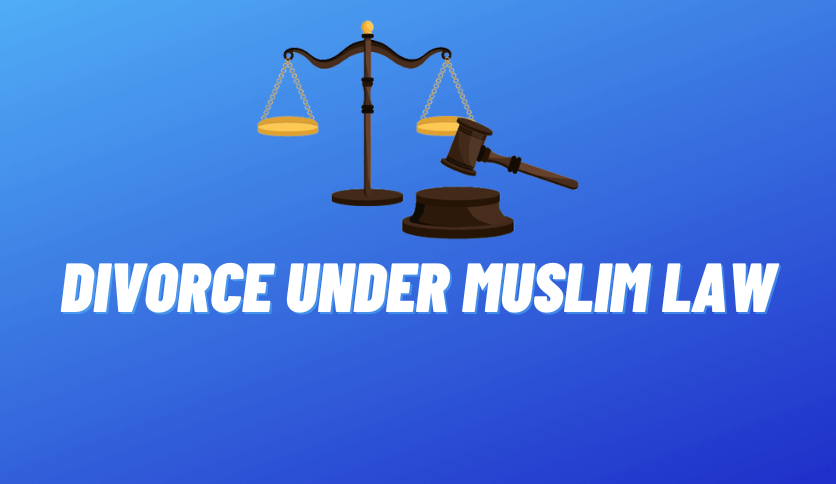If you’re looking to know about divorce under muslim law? then, read this article to know about divorce under muslim law.

Contents
Divorce under Muslim law:
The process of divorce under Muslim law in India consists of multiple dimensions that combine Islamic religious principles alongside legal adjustments and court decisions. This article offers an extensive analysis of Muslim legal divorce practices in India alongside their modern-day marriage evolution in the country.
History of Divorce under Muslim Law:
Pre-Islamic Era
Before Islam took hold, Arab men maintained complete authority to terminate their marriages. The Islamic legal system allows any husband to end his marriage spontaneously using divorce regardless of reason. The husband exercised a limitless power of divorce which he could issue and retract freely on any occasion of his choice. The laws of the time recognized at least four methods to terminate marriages. Women could seek remarriage following divorce yet needed to wait through iddat when the divorce occurred in order for paternity verification. During this period the iddat waiting period was not consistently followed by the society.
Post-Islamic Era
The new Islamic teachings brought by Prophet Muhammad brought an end to nonregulated marriage and divorce practices. According to him, the improper application of divorce harmed the underlying structure of family life. Given their strong cultural roots, the Prophet Muhammad chose to introduce evolutionary changes instead of immediate bans. During that period husbands could file for divorce yet state regulations limited their ability by placing fairness requirements and social stability conditions on their permission to divorce.
The law now afforded women the right to pursue marital separation based on reasonable reasons which enabled them to end their unions legally. The religious law enacted a new requirement that prevented women from reuniting with their former husbands after divorce unless they married another man, had sexual relations with him and observed the iddat period following the first divorce.
Critics found this requirement unacceptable because they consider it degrading toward women who experience embarrassment due to this judicial requirement that erodes their dignity.
Forms of Divorce in Muslim Law:
1. Talaq (Divorce by Husband)
A Muslim husband possesses the unilateral power to end his marriage with his wife. It manifests in several forms:
The most favoured method of Talaq-e-Ahsan requires a husband to declare divorce at a time of purity and then maintain separation throughout the iddat waiting period.
Under Talaq-e-Hasan a husband must pronounce divorce three times during three successive tuhrs without engaging in sexual relations between pronunciations.
Under Talaq-e-Biddat (Instant Triple Talaq) a husband declares divorce three times without interruption which results in an instant and permanent separation of his wife. The Supreme Court through its Shayara Bano v. Union of India (2017) decision declared this divorce method invalid. The practice of instant triple divorce is now illegal according to the Muslim Women (Protection of Rights on Marriage) Act, 2019 and carries a prison term of up to three years.
One common question that arises after divorce is whether the wife has any legal claim over the husband’s property. Under the Indian Divorce Act, 1869, there is no automatic right to property, but courts may award maintenance or alimony based on the wife’s financial condition and the husband’s capacity. This guide explains whether and how a wife can claim her husband’s property after divorce in India, including the difference between maintenance and actual ownership rights.
2. Divorce by Wife
Traditionally Muslim women faced restricted options for divorce yet certain established provisions enable them to initiate divorces.
A husband through Talaq-e-Tafweez gives his wife the power to perform divorce either at the wedding or on a later date. A husband may grant his wife the power to issue talaq divorces under particular circumstances including his second marriage or his failure to provide financial support.
The wife can initiate Khula’s divorce by offering compensation to her husband to gain his permission to end the marriage. The procedure involves mutual consent together with observing the iddat period.
When spouses agree to end their marriage it is known as Mubarak. Two consenting spouses end their marriage and need to follow iddat restrictions during which period the marriage dissolves.
Alimony or maintenance is often a critical part of divorce proceedings, especially when one spouse is financially dependent on the other. Under the Indian Divorce Act, 1869, courts may grant permanent or interim alimony to ensure financial stability for the affected party, usually the wife. This detailed guide breaks down the divorce alimony rules in India, including how the amount is calculated and what factors courts consider when awarding it.
3. Judicial Divorce (Faskh)
A Muslim woman can apply for judicial divorce under the Dissolution of Muslim Marriages Act 1939 through established grounds.
- Husband’s disappearance for four years.
The law grants two years for a husband to provide maintenance but failure to do so can lead to a divorce.
- Husband’s imprisonment for seven years or more.
- Husband’s impotence, insanity, or affliction with a virulent venereal disease.
- Cruelty or mistreatment by the husband.
A Muslim marriage formed before a woman turns 15 remains valid if the marriage remains unconsumed and she rejects it before her 18th birthday.
Legal Framework and Reforms:
Muslim Women (Protection of Rights on Marriage) Act, 2019
The Act makes instant triple talaq (talaq-e-biddat) illegal by declaring it null and unlawful. Under this law, the husband may face three years imprisonment while Muslim women receive protection for maintenance alongside exclusive custody rights for their minor children.
Muslim Women (Protection of Rights on Divorce) Act, 1986
This Act followed the Shah Bano Supreme Court decision to restrict husbands’ maintenance obligations to the iddat period duration. New judicial interpretations of this law now recognize that divorced Muslim women should receive post-idat period maintenance in particular situations.
Legal Effects of Divorce under Muslim Law:
Under Muslim law, divorce produces various substantial legal aftereffects that modify the rights and responsibilities of former spouses. Divorce results in the elimination of inheritance rights that spouses normally have toward each other. The termination of marriage eliminates the inheritance rights according to Islamic principles that both ex-spouses held toward each other.
After obtaining a divorce any cohabitation between the ex-husband and ex-wife transitions to an illegal act. The relationship remains illicit for former spouses who stay together sexually without concluding a new marriage (nikah) contract. Children conceived during this illicit relationship will lack legal recognition as per Muslim law.
The immediate implementability of unpaid dowery (mahr) by the wife becomes mandatory after divorce. A divorced husband becomes legally bound to give his wife her entire dower payment at any time after the divorce takes place no matter when he originally gave it.
The parties involved have the right to initiate new marital unions after their iddat period ends according to Muslim law. Muslim women need to wait for three menstrual cycles or three lunar months before getting remarried following the end of marriage during iddat. The husband must maintain financial support for his wife throughout the iddat period because this ensures her basic needs before marriage and independence.
Recent Developments:
Uniform Civil Code (UCC) Initiatives
The Indian state Uttarakhand became the pioneer to enact a Uniform Civil Code in February 2024 which unified all religious personal law provisions regarding marriage divorce inheritance and adoption. The Uniform Civil Code (UCC) prevents Muslim men from performing polygamous marriages or using instant triple talaq because these restrictions work to achieve gender equality while ending female discrimination. The legislative move encounters support as an evolution but generates opposition because it allegedly violates religious freedom statutes and aims this reform at Muslim religious law frameworks.
Shayara Bano v. Union of India (2017)
Facts of the Case:
- The petitioner Bano asked the courts to invalidate the triple talaq divorce that Rizwan Ahmed declared against her.
- He declared three instances of divorce which severed his marital bonds with her in front of witnesses on October 10th 2015.
- The court declared she was free to choose her path and no longer followed the rules of naamharram.
- Shayara Bano requested the court to establish that the divorce should be viewed as nonexistent from its start (void ab initio) and asked the court to declare triple talaq unconstitutional.
- She stated that triple talaq did not belong to Shariat law and thus should be excluded from Muslim Personal Law protection.
- The Supreme Court demonstrated its attention through various directions which led the central government to establish a high-level examination committee dedicated to the practice.
- The petitioner used the United Nations Charter from 1945 as well as international views to establish their position.
- Cadres at the Law Commission of India submitted prospective solutions to help resolve triple talaq problems.
Contentions by the Petitioner:
- Triple talaq remains invalid under the provisions of the Shariat Application Act, of 1937.
- The Prophet never supported this practice yet people eventually continued it through custom even though the Quran did not confirm it.
- Triple talaq violates the basic rights of equality before the law according to Article 14 and prohibits discrimination under Article 15.
- Muslim women have the right to possess equal positions and self-governance across all personal and legal domains that involve marriage and divorce.
Contentions by the Respondents:
- Through the Shariat Application Act of 1937 courts only authorize existing traditions in Muslim Personal Law.
- Islam defines marriage as a civil contractual relationship that the Parliament cannot address through legislative action.
- The respondents maintained that since personal laws are excluded from constitutional law definitions triple talaq falls outside legal examination.
- Through Article 25 of the Constitution, the practice of personal religious laws remains protected unless parliament chooses to regulate the secular parts of religious customs.
Judgment of the Court:
- A 3:2 majority at the Supreme Court established a ruling that made instant triple talaq (talaq-e-biddat) unlawful.
- During the six-month suspension the court instructed the Parliament to create proper legislation before the period ended.
- A full 264-page judgment provided extensive analysis of the constitutional along with legal and international aspects of this matter.
- The decision emphasized gender equality together with constitutional ethics and contemporary changes in Islamic family law practices of today.
Conclusion
The Muslim divorce system in India applies Islamic traditions alongside current legal system modifications. The various legal paths that spouses have to end their marriages receive additional balance from current legislative and judicial efforts which combine religious traditions with constitutional equality and justice principles. Current public discussions regarding the Uniform Civil Code alongside secular governance principles influence how the Indian Muslim community addresses marriage and divorce issues.
Hope this article: divorce under muslim law was useful to you, feel free to share it in your circle, if you have any doubts ask it in the comment section, if you’re seeking for legal advice then feel free to connect with divorce advocate in bangalore for better clarity in handling your legal problem.
About the Author – Advocate Priya Narayan

Advocate Priya Narayan is a seasoned divorce and family law attorney based in Bangalore, with over 12 years of courtroom experience. She has represented 500+ clients across a wide range of matrimonial cases — including divorce, child custody, alimony, domestic violence, and mutual consent petitions under Hindu, Muslim, Christian, and Special Marriage Acts.
Her deep understanding of personal laws, combined with real courtroom insights, helps clients navigate complex legal situations with clarity and confidence. Advocate Priya is known for her strategic litigation skills, empathetic client approach, and a strong track record in achieving favorable settlements both inside and outside the courtroom.
Office located in: Indiranagar, Bangalore
Email: contact@bestdivorcelawyerinbangalore.com
Phone: +91-9361722724
This article is based on her legal understanding and practical experience in Indian family courts.
Need guidance on your case? Schedule a confidential consultation with Advocate Priya Narayan.